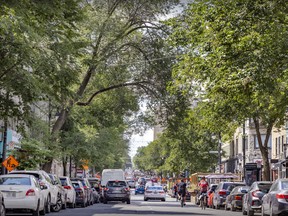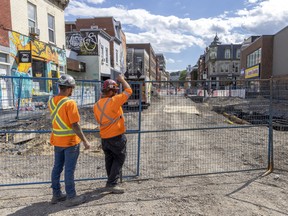“They create an elevation in the street that is different from the lollipop trees” that replaced them.

.
In the 1940s, there were an estimated 35,000 American elms in Montreal. They towered up to 80 feet above streets like Sherbrooke and St-Hubert, arching toward each other to create thick green canopies over the road.
Announcement 2
.
Almost all disappeared a few decades later, wiped out by Dutch elm disease. Today, only a few hardy survivors of those original elms remain.
But this tree icon is making a comeback. The city is renovating Pine Ave. between Hutchison St. and St-Denis St., and when the work is complete next year, there will be 150 new trees along this previously stripped artery. Four species will be planted, including lime and hackberry, as well as two types of elms: Brandon and Accolade. It is the latest step in the rebirth of a beloved tree that once defined Montreal’s urban landscape.
“Dutch elm disease struck the public imagination because there were entire streets lined with elm trees. People called them green cathedrals,” says Louis Bernier, a professor in the forestry department at Université Laval. “It started in the 19th century when millions of elms were planted in North American cities. There is an Elm St. in every city and that is because there were so many elm trees.”
Announcement 3
.
The reason for the popularity of the American elm is that, in many ways, it is the perfect urban tree.
“It is a species that is very resistant to many types of stresses,” says Bernier, such as drought, wind, compacted soil, and even road salt and abrasives that are plentiful during winter.
On top of that, there is the charm of its elegant wine glass shape. Long, slender trunks rise in an umbrella-like tuft of oval-shaped leaves. It is the quintessential type of tree one would draw as a child: “a great green cloud” is how The New Yorker described them in an elegiac profile that was published in 1961. Even when the tree loses its leaves for winter, its vase- The similar profile remained so distinctive that they were easy to spot.
“No other tree looks like the American elm against the sky,” nature photographer William M. Harlow once said.
Announcement 4
.

Dutch elm disease is caused by a fungus spread by bark beetles. It made its way from Asia to Europe, where it was first identified by Dutch scientists, before landing in New York in the 1920s. It spread across most of the continent, decimating nearly every elm tree in its path. About 75 percent of North American elms died, with a higher proportion in many cities: 80 percent in Toronto, more than 90 percent in Montreal.
Here, many elms have been replaced by shorter, bushier ash trees, which are now fighting their own epidemic. For heritage advocate Dinu Bumbaru, the effect was similar to what happens when historic buildings are torn down and replaced with something new: the face of the city is forever changed. “Part of the appeal of the elms was the way they were,” he says. “They created an elevation in the street that is different from the lollipop trees we have today.”
ad 5
.
Not everywhere suffered the same fate. Dutch elm disease never reached Alberta, where the streets of Edmonton are still shaded by American elms; Quebec City managed to save 21,000 of its elm trees, thanks in part to its particularly cold winters, as well as an aggressive control and prevention program that continues today.
Now the elms are finally making a comeback in Montreal. Arborists have cultivated disease-resistant specimens, including the Accolade elm, which was developed by Chicago’s Morton Arboretum as a hybrid of two different Asian elms whose shape resembles the classic American elm. In the last 10 years, more than 3,900 awards have been planted in Montreal. On St-Laurent Blvd. near Prince Arthur St., Accolade elms planted in the summer of 2008 are already beginning to tower over adjacent buildings.
ad 6
.
The Brandon elm, which will also be planted on Pine Ave., is relatively new. Derived from a native elm in Brandon, Man., the city’s public tree records indicate there are only 103 individuals scattered throughout Montreal. Louis Bernier and his former colleague, retired forestry engineer Guy Bussières, say they aren’t sure if it can resist Dutch elm disease.
City spokeswoman Mélanie Dallaire says they are, in fact, disease resistant. But she also points out that the city has learned from past mistakes. “It was decided to bring the elms back to Pine, but this time they will be integrated into a new community of diverse species because we avoid monocultures,” she says. “The archetypal scene of rows of elm trees, in the image of the great American avenues, will not be recreated.”
But, he adds, “that doesn’t change the fact that the elm is a remarkable and graceful species that deserves its place on the streets of Montreal.”
The elms are back, along with a part of Montreal’s heritage.
-
History Through Our Eyes: May 10, 1978, Replacing Lost Elms
-
40,000 trees will be felled in the battle against the emerald ash borer



